1993 CADILLAC FLEETWOOD tow
[x] Cancel search: towPage 105 of 386
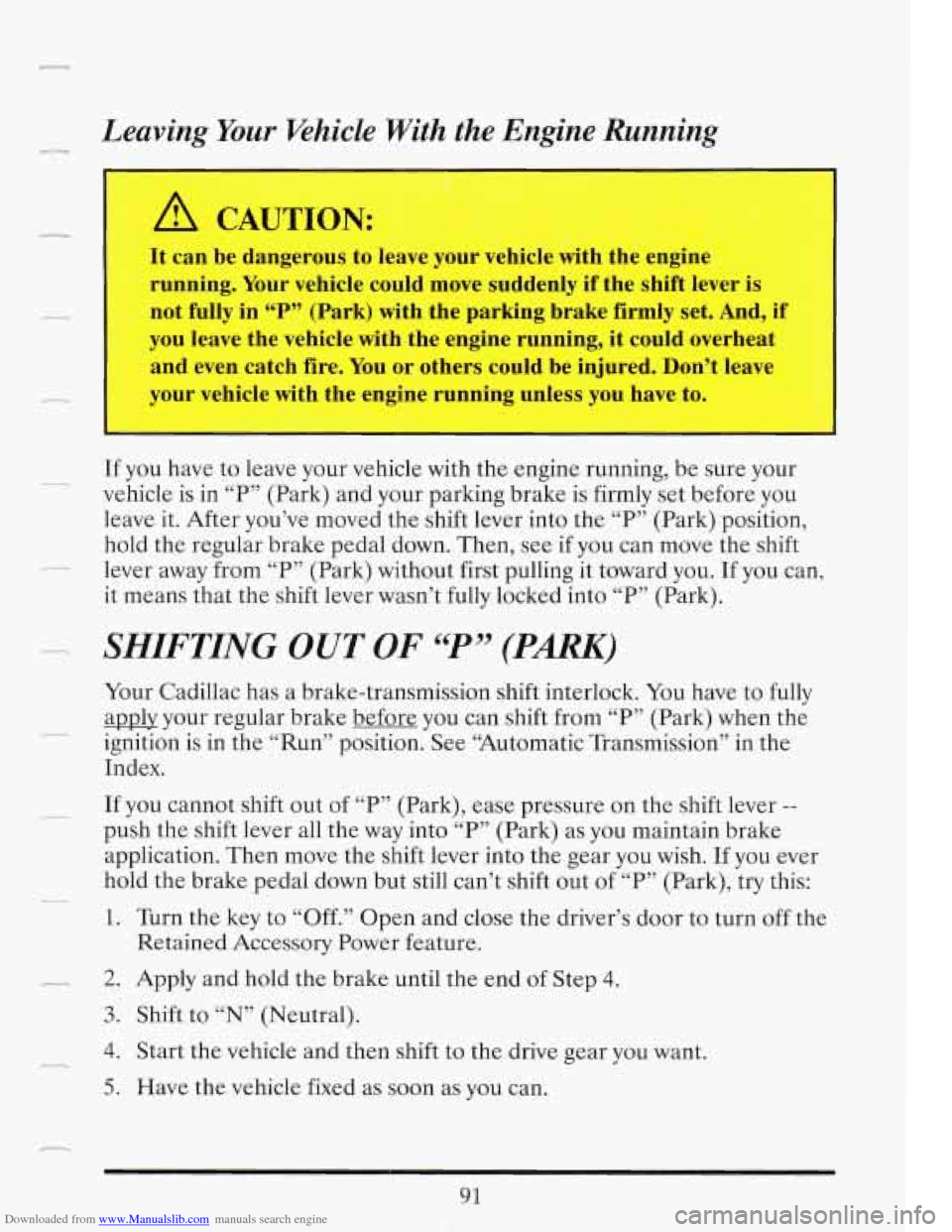
Downloaded from www.Manualslib.com manuals search engine Leaving Your Pkhicle With the Engine Running
----
A CAUTION:
It can be dangerous to leave your vehicle with the engine
running. Your vehicle could move suddenly if the shift lever is
not fully in “P” (Park) with the parking brake firmly set. And, if
you leave the vehicle with the engine running, it could overheat
and even catch fire. You or others could be injured. Don’t leave
your vehicle with the engine running unless you have to.
If you have to leave your vehicle with the engine running, be sure your
vehicle is in “P” (Park) and your parking brake is firmly set before you
leave it. After you’ve moved the shift lever into the “P” (Park) position,
hold the regular brake pedal down. Then, see if you can move the shift
lever away from “P” (Park) without first pulling it toward you. If you can,
it means that the shift lever wasn’t fully locked into “P” (Park).
SHIFTING OUT OF “P” (PARK)
Your Cadillac has a brake-transmission shift interlock. You have to fully
apply your regular brake before you can shift from “P” (Park) when the
ignition is in the “Run” position. See “Automatic Transmission” in the
Index.
If you cannot shift out of “P” (Park), ease pressure on the shift lever --
push the shift lever all the way into “P” (Park) as you maintain brake
application. Then move the shift lever into the gear you wish.
If you ever
hold the brake pedal down but still can’t shift out
of “P” (Park), try this:
1.
2.
3.
4.
5.
Turn the key to “Off.” Open and close the driver’s door to turn off the
Retained Accessory Power feature.
Apply and hold the brake until the end of Step
4.
Shift to “N” (Neutral).
Start the vehicle and then shift to the drive gear you want.
Have the vehicle fixed as
soon as you can.
91
Page 108 of 386
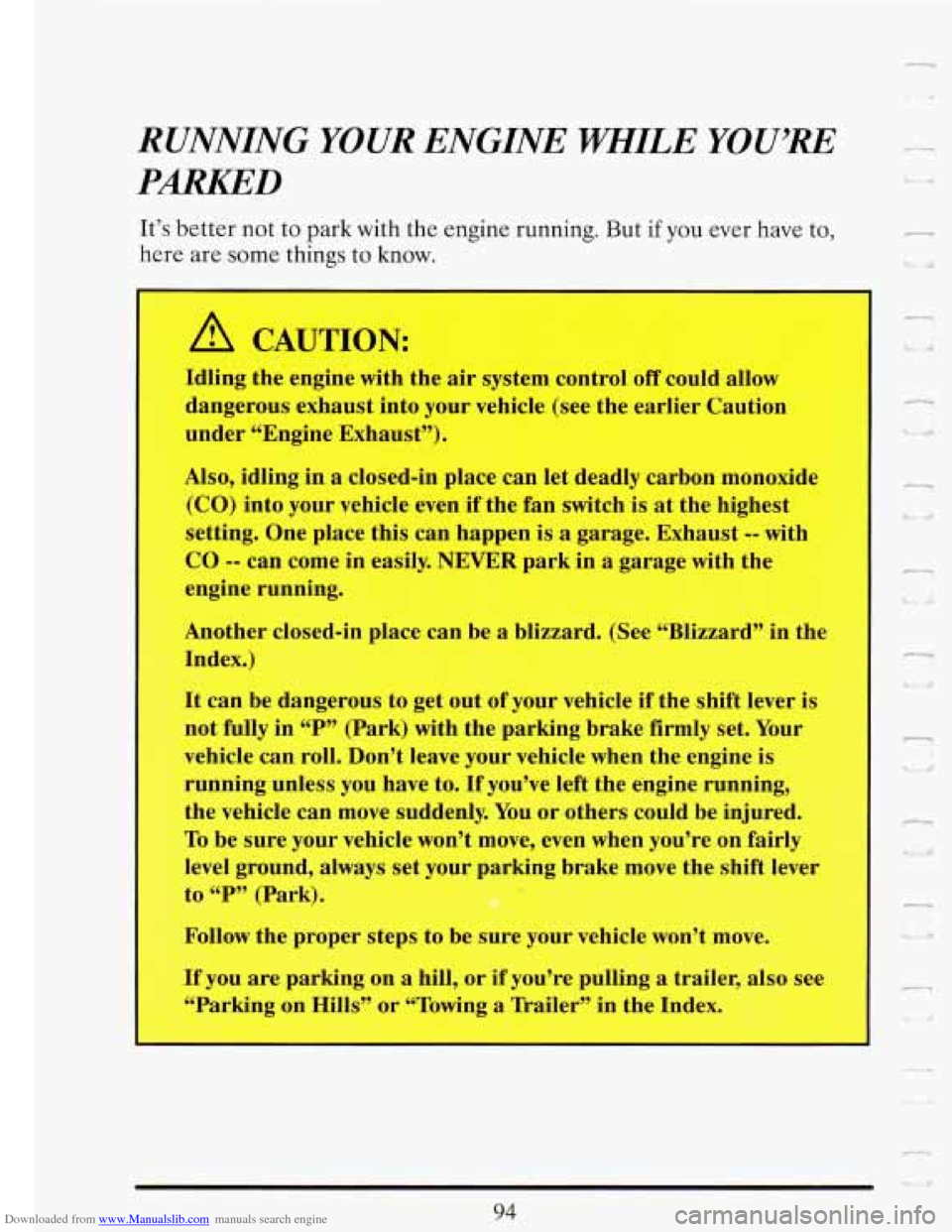
Downloaded from www.Manualslib.com manuals search engine RUNNING YOUR ENGINE WHILE YOU’RE
PARKED
It’s better not to park with the engine running. But if you ever have to,
here are some things to know.
A CAUTION:
Idling the engine with the air system control off could allow
dangerous exhaust
into your vehicle (see the earlier Caution
under “Engine Exhaust”).
Also, idling in a closed-in place can let deadly I- --moa monoxide
(CO) into your vehicle even if the fan switch is at the highest
setting. One place this
can happen is a garage. Exhaust -- with
CO -- can came in easily. NEWER park in. a garage with the
engine running.
Another
closed-in place can be a blizzard. (See “Blizzard” in the
Index,)
It can be dangerous to get out of your vehicle if the shift lever is
not fnhly in “P” (Park) with the parking brake firmly set. Your
vehicle can dI. l3on’t leave your vehicle when the engine is
running unless you have to. If you’ve left the engine running,
the vehicle can move suddenly. You or others could be injured.
Ta be $we your vehicle won’t move, even when you’re on fairly
level
ground, always set your parking brake move the shift lever
to “P” (Park). i
Follow the proper steps to be sure your vehicle won’t move,
If you ,am parking on zt hill, OT if you’re pulling a trailer, also see
“Parking on Hills” or “Towing a Ikrriler” in the Index.
94
- ’i LY
Page 113 of 386
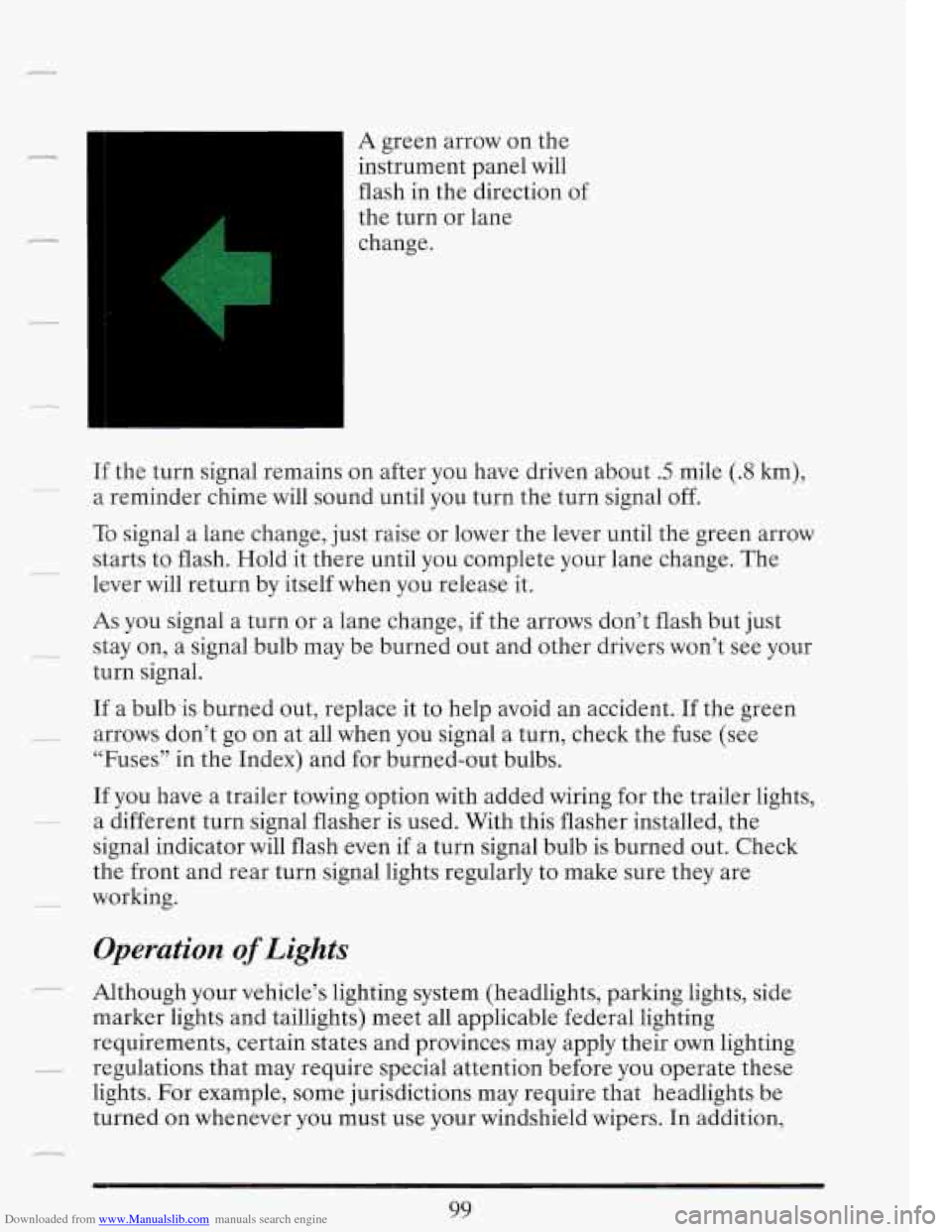
Downloaded from www.Manualslib.com manuals search engine A green arrow on the
instrument panel will
flash in the direction of
the turn or lane
change.
If the turn signal remains on after you have driven about .5 mile (.8 km),
a reminder chime will sound until you turn the turn signal off.
To signal a lane change, just raise or lower the lever until the green arrow
starts to flash. Hold it there until you complete your lane change. The
lever will return by itself when you release it.
AS you signal a turn or a lane change, if the arrows don’t flash but just
stay on, a signal bulb may be burned out and other drivers won’t see your
turn signal.
If a bulb is burned out, replace it to help avoid an accident. If the green
arrows don’t go on at all when you signal a turn, check the fuse (see
“Fuses” in the Index) and for burned-out bulbs.
If you have a trailer towing option with added wiring for the trailer lights,
a different turn signal flasher is used. With this flasher installed, the
signal indicator will flash even if a turn signal bulb is burned out. Check
the front and rear turn signal lights regularly to make sure they are
working.
Operation of Lights
Although your vehicle’s lighting system (headlights, parking lights, side
marker lights and taillights) meet all applicable federal lighting
requirements, certain states and provinces may apply their own lighting
regulations that may require special attention before you operate these
lights. For example, some jurisdictions may require that headlights be
turned on whenever you must use your windshield wipers. In addition,
Page 114 of 386
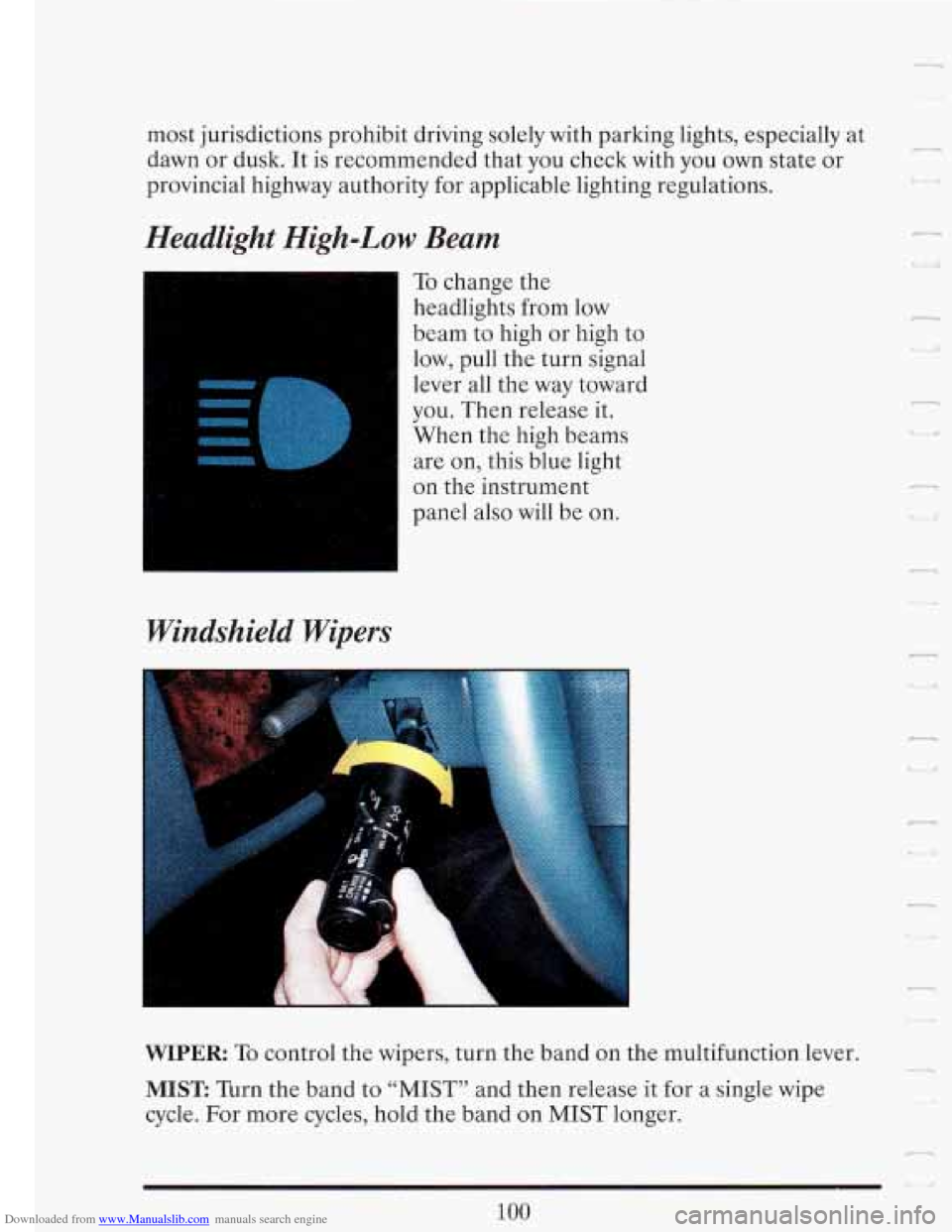
Downloaded from www.Manualslib.com manuals search engine most jurisdictions prohibit driving solely with parking lights, especially at
dawn or dusk. It is recommended that you check with
you own state or
provincial highway authority for applicable lighting regulations.
Headlight High-Low Beam
Windshield Wipers
To change the
headlights from low
beam to high or high to
low, pull the turn signal
lever all the way toward
you. Then release it.
When the high beams
are on, this blue light
on the instrument
panel also will be on.
WIPER To control the wipers, turn the band on the multifunction lever.
MIST: Turn the band to “MIST” and then release it for a single wipe
cycle. For more cycles, hold the band on MIST longer.
1 :I, U
100
Page 115 of 386
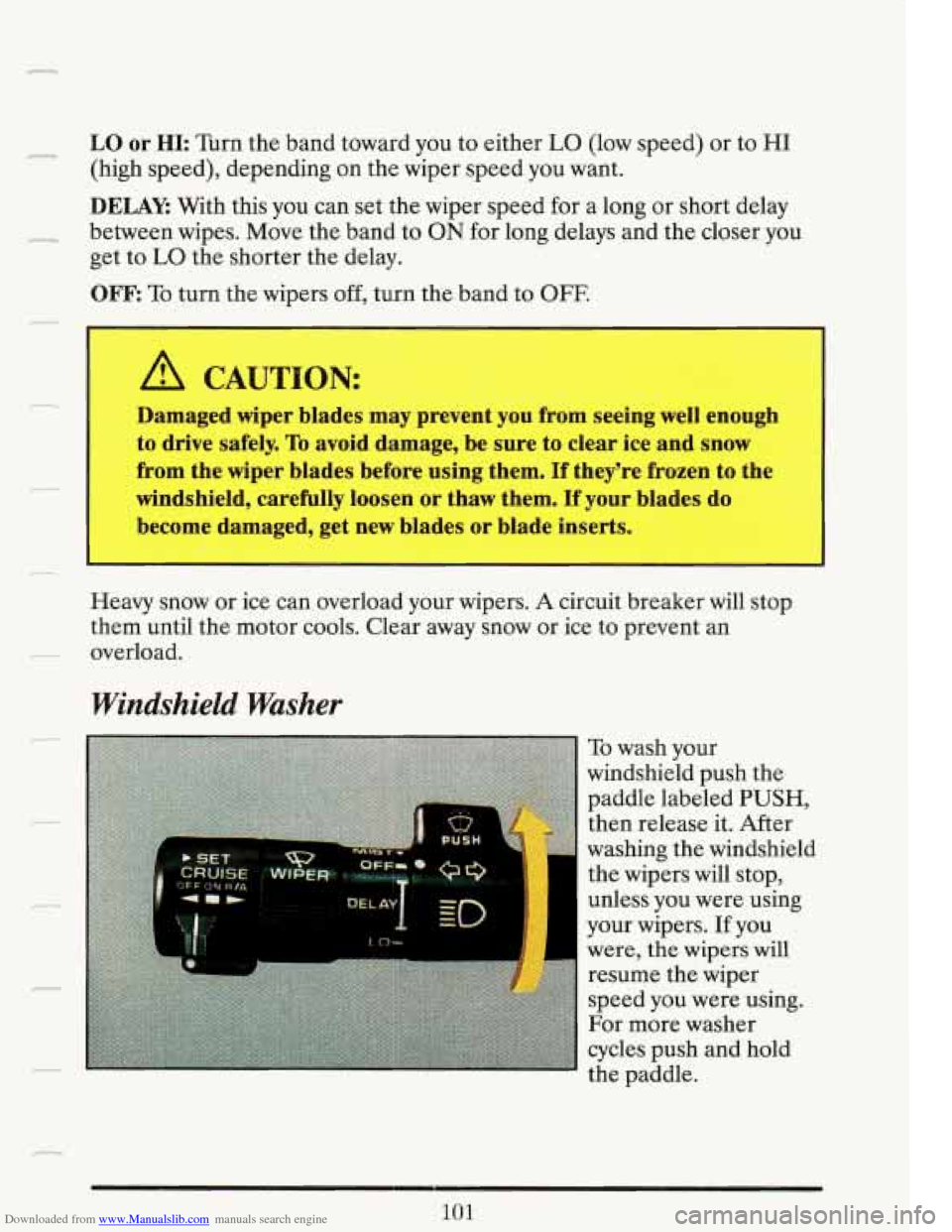
Downloaded from www.Manualslib.com manuals search engine - LO or HI: Turn the band toward you to either LO (low speed) or to HI
(high speed), depending on the wiper speed you want.
DELAY With this you can set the wiper speed for a long or short delay
get to
LO the shorter the delay.
7 between wipes. Move the band to ON for long delays and the closer you
OFI? To turn the wipers off, turn the band to OFF.
A CAUTION:
Damaged wiper blades may prevent you from seeing well enough
to drive safely.
To avoid damage, be sure to clear ice and snow
from the wiper blades before using them.
If they're frozen to the
windshield, carefully loosen or thaw them.
If your blades do
become damaged, get new blades or blade inserts.
Heavy snow or ice can overload your wipers.
A circuit breaker will stop
them until the motor cools. Clear away snow or ice to prevent an
-- overload.
Windshield Washer
- To wash your
windshield push the
paddle labeled PUSH,
then release it. After
washing the windshield
the wipers will stop,
your wipers.
If you
were,
the wipers will
- resume the wiper
speed you were using.
For more washer
cycles push and hold
the paddle.
-
L_ unless you were using
_I
1111
101
Page 132 of 386
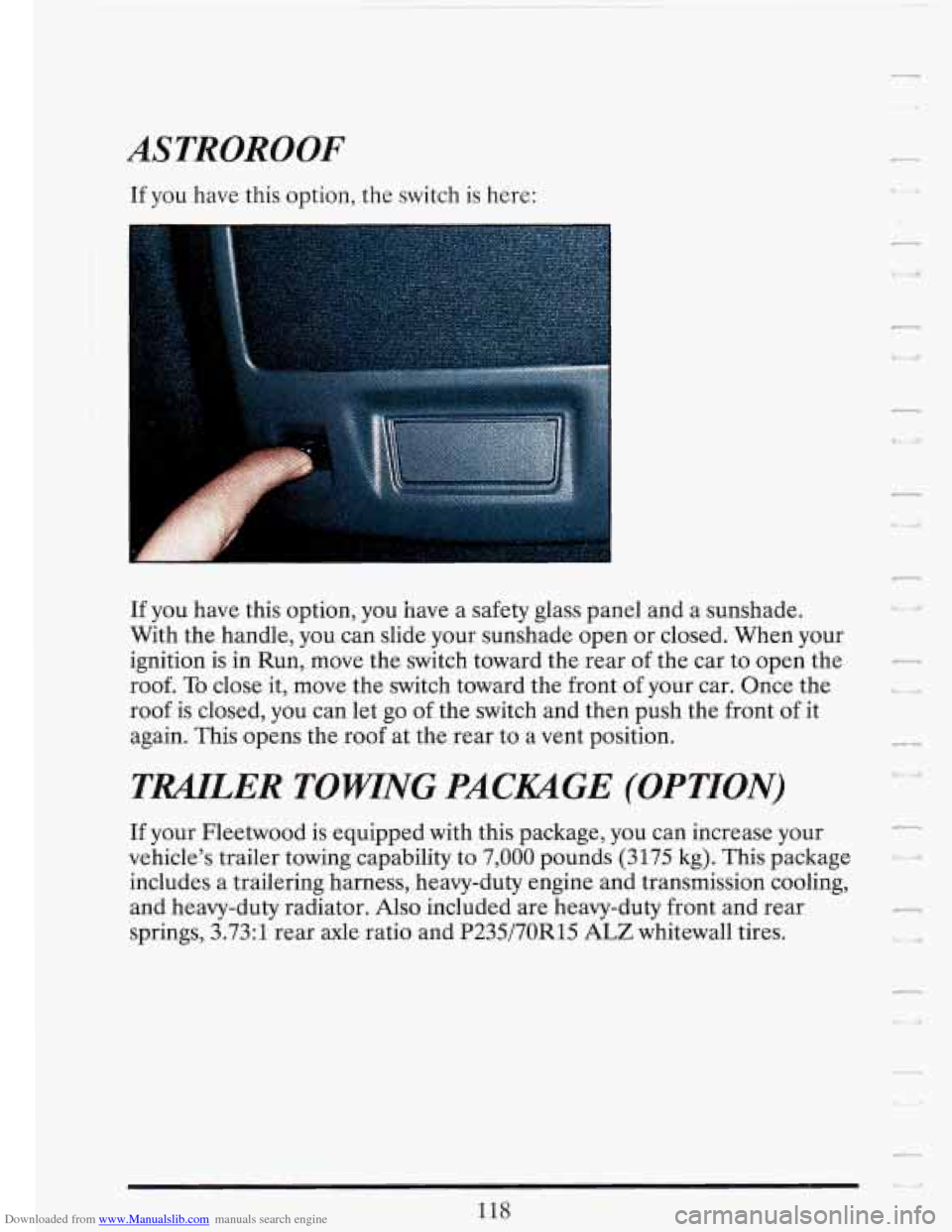
Downloaded from www.Manualslib.com manuals search engine ASTROROOF
If you have this option, the switch is here:
_.
If you have this option, you have a safety glass panel and a sunshade.
With the handle, you can slide your sunshade open or closed. When your
ignition is
in Run, move the switch toward the rear of the car to open the
roof.
To close it, move the switch toward the front of your car. Once the
roof is closed, you can let
go of the switch and then push the front of it
again. This opens the roof at the rear to a vent position.
TWLER TOWING PACKAGE (OPTION)
If your Fleetwood is equipped with this package, you can increase your 7
vehicle's trailer towing capability to 7,000 pounds (3175 kg). This package '
includes a trailering harness, heavy-duty engine and transmission cooling,
and heavy-duty radiator.
Also included are heavy-duty front and rear
springs, 3.73:l rear axle ratio and P235/70R15
ALZ whitewall tires.
7
n
Page 140 of 386
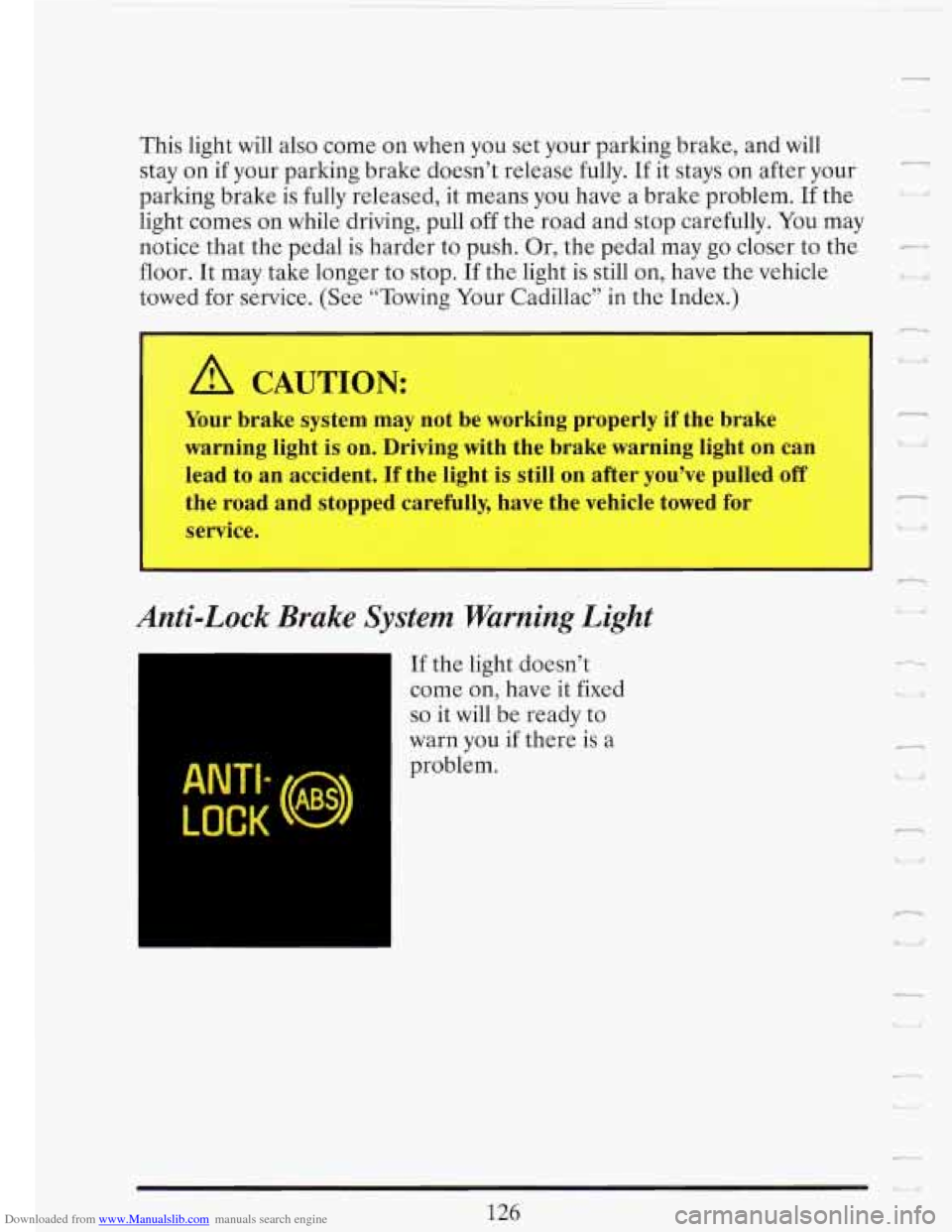
Downloaded from www.Manualslib.com manuals search engine -I
This light will also come on when you set your parking brake, and will
stay on if your parking brake doesn’t release fully. If it stays
on after your
parking brake is fully released, it means you have a brake problem.
If the
light comes on while driving, pull off the road and stop carefully.
You may
notice that the pedal
is harder to push. Or, the pedal may go closer to the
floor. It may take longer to stop. If the light is still
on, have the vehicle
towed for service. (See “Towing Your Cadillac” in the Index.)
A CAUTION:
Your brake system may not be working properly if the brake
warning light
is on. Driving with the brake warning light on can
lead to an accident.
If the light is still on after you’ve pulled off
the road and stopped carefully, have the vehicle towed for
service.
~
Anti-Lock Brake System Warning Light
ANTI
(
If the light doesn’t
come on, have
it fixed
so it will be ready to
warn you if there is a
problem.
126
,_.
h&
I n
w
4 .,
Page 180 of 386
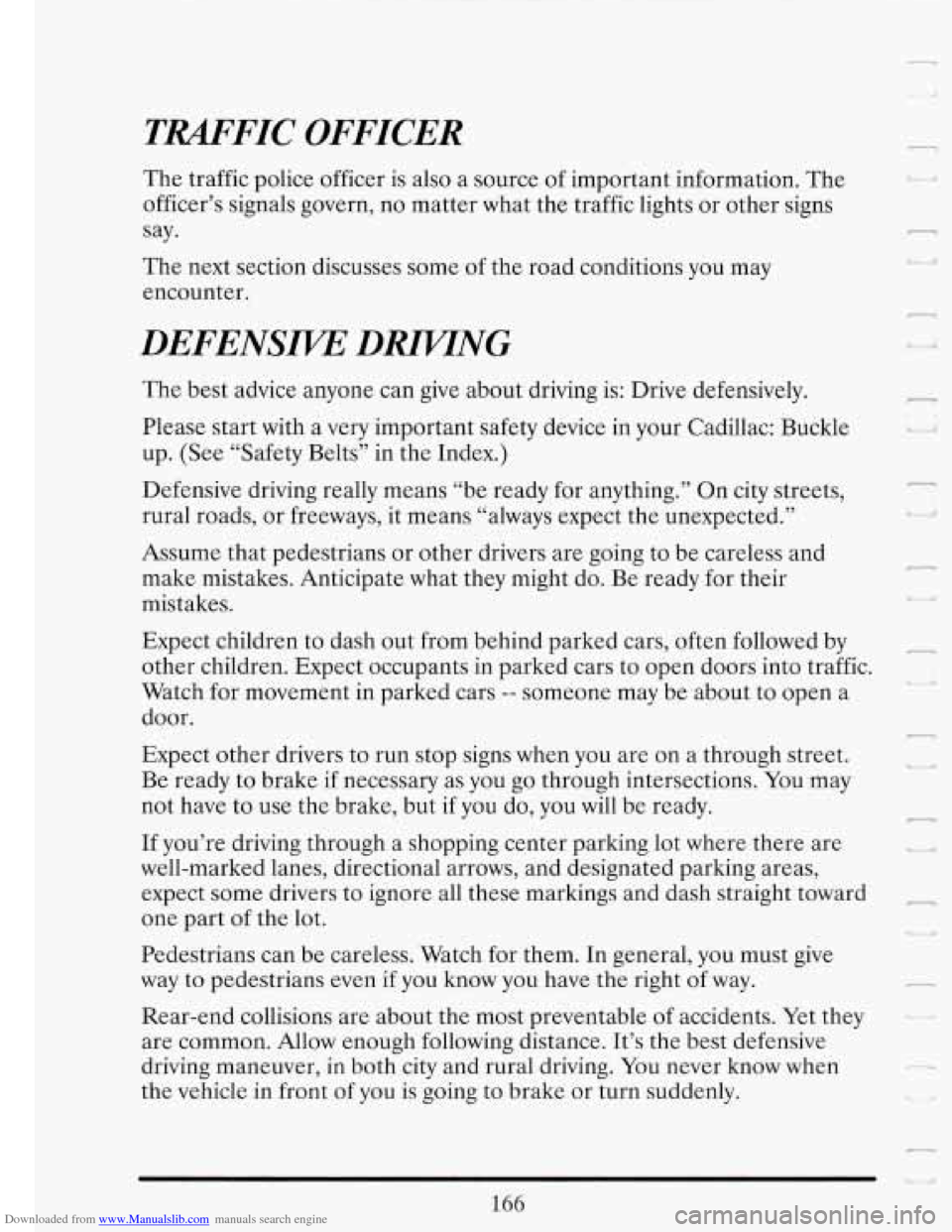
Downloaded from www.Manualslib.com manuals search engine TRAFFIC OFFICER 7 .. I: The traffic police officer is also a source of important information. The
officer’s signals govern, no matter what the traffic lights or other signs
say.
The next section discusses some of the road conditions you may
encounter.
DEFENSIVE DlUVTNG
The best advice anyone can give about driving is: Drive defensively.
Please start with a very important safety device
in your Cadillac: Buckle
up. (See “Safety Belts” in the Index.)
Defensive driving really means “be ready for anything.’’ On city streets,
rural roads, or freeways, it means “always expect the unexpected.”
Assume that pedestrians or other drivers are going to be careless and
make mistakes. Anticipate what they might do. Be ready for their
mistakes.
Expect children to dash out from behind parked cars, often followed by
other children. Expect occupants in parked cars to open doors into traffic.
Watch for movement
in parked cars -- someone may be about to open a
door.
Expect other drivers to run stop signs when you are on a through street.
Be ready to brake if necessary as you
go through intersections. You may
not have to use the brake, but
if you do, you will be ready.
If you’re driving through a shopping center parking lot where there are
well-marked lanes, directional arrows, and designated parking areas,
expect some drivers
to ignore all these markings and dash straight toward
one part of the lot.
Pedestrians can be careless. Watch for them. In general, you must give
way to pedestrians even if you know you have the right of way.
Rear-end collisions are about the most preventable of accidents. Yet they
are common. Allow enough following distance.
It’s the best defensive
driving maneuver,
in both city and rural driving. You never know when
the vehicle in front of you is going to brake or turn suddenly.
166
n
U i I‘
n
u
! I,
r
r
d
-
1